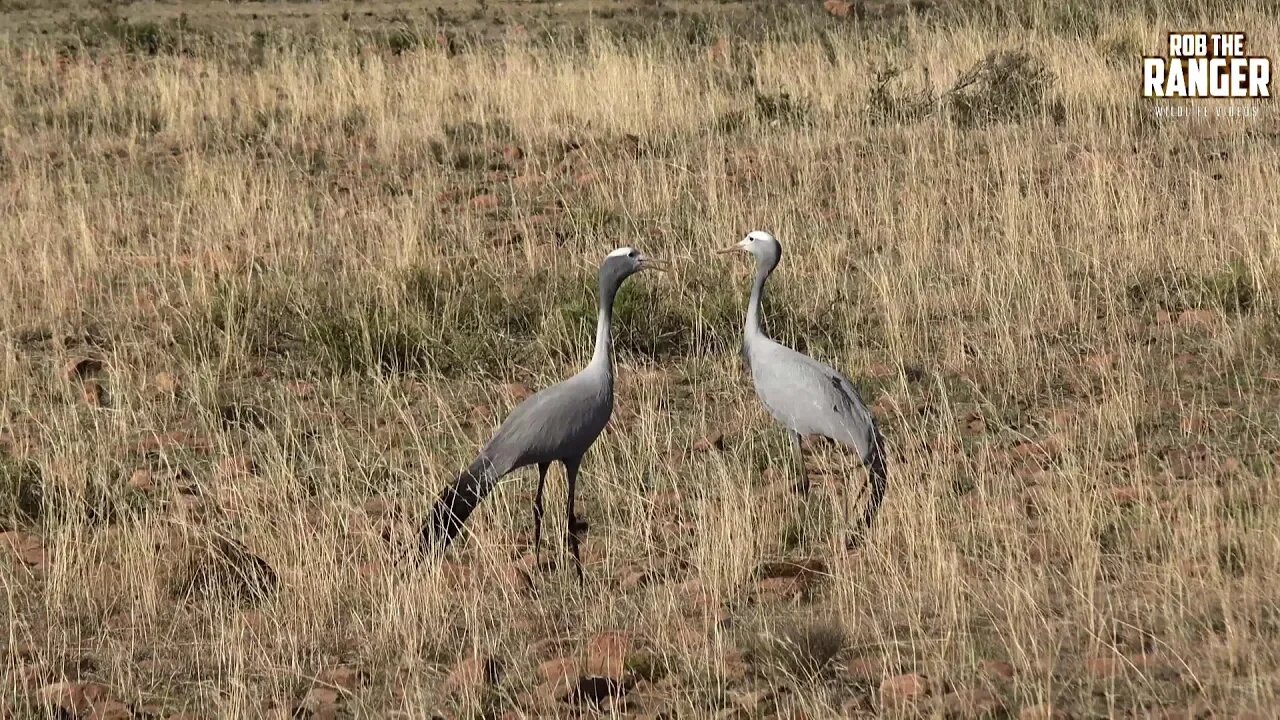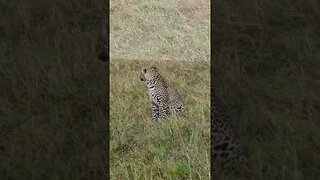Premium Only Content

The Blue Crane: National Bird Of South Africa
A pair of Blue Crane vocalising in the Mountain Zebra National Park, South Africa
The blue crane (Grus paradisea), also known as the Stanley crane and the paradise crane, is the national bird of South Africa. The species is listed as Vulnerable by the IUCN.
Blue cranes are birds of the dry grassy uplands, usually the pastured grasses of hills, valleys, and plains with a few scattered trees. They prefer areas in the nesting season that have access to both upland and wetland areas, though they feed almost entirely in dry areas. They are altitudinal migrants, generally nesting in the lower grasslands of an elevation of around 1,300 to 2,000 m and moving down to lower altitudes for winter. Though historically found in areas of low human disturbance, the blue crane is currently thriving in the highly transformed agricultural areas of the Western Cape. This is the only portion of its range where the population is increasing, though they still face threats such as poisoning in the region.
Of the 15 species of crane, the blue crane has the most restricted distribution of all. Even species with lower population numbers now (such as Siberian or whooping cranes) are found over a considerable range in their migratory movements. The blue crane is migratory, primarily altitudinal, but details are little known.
The blue crane is partially social, less so during the breeding season. There is a strict hierarchy in groups, with the larger adult males being dominant. They overlap in range with 3 other crane species but interactions with these species and other "large wader" type birds are not known. They are relentlessly aggressive to various other animals during the nesting season, attacking non-predatory species such as cattle, tortoises, plovers and even sparrows. Humans are also attacked if they approach a nest too closely, with the aggressive male having torn clothes and drawn blood in such cases.
Blue cranes feed from the ground and appear to rarely feed near wetland areas. Most of their diet is comprised by grasses and sedges, with many types fed on based on their proximity to the nests. They are also regularly insectivorous, feeding on numerous, sizeable insects such as grasshoppers. Small animals such as crabs, snails, frogs, small lizards and snakes may supplement the diet, with such protein-rich food often being broken down and fed to the young.
The breeding period is highly seasonal, with eggs being recorded between October and March. Pair-formation amongst groups often beings in October, beginning with both potential parents running in circles with each other. The male then engages in a "dance" flings various objects in the air and then jumps. Eventually, a female from the group and the male appear to "select" each other and both engage in the dance of throwing objects and jumping. After the dance, mating commences in around two weeks.
In a great majority of known nests, two eggs are laid (rarely 1 or 3). Both males and females will incubate, with the male often incubating at night and, during the day, defending the nest territory while the female incubates. The incubation stage lasts around 30 days. The young are able to walk after two days and can swim well shortly thereafter. They are fed primarily by their mothers, who regurgitates food into the mouths. The chicks fledge in the age of 3–5 months.[5] The young continue to be tended to until the next breeding season, at which time they are chased off by their parents.
Filmed in 4K UHD resolution using the Sony AX100 4K video camera: https://go.magik.ly/ml/hory/
Subscribe: https://bit.ly/30a0IRM | Merch: http://teespring.com/stores/robtheranger
Watch the newest videos: https://www.youtube.com/playlist?list=PLLLkJbMHt1booI-NVZ7lZxheEp8UMFRYE
Follow Rob The Ranger:
TWITTER: http://goo.gl/U8IQGf
INSTAGRAM: https://instagram.com/robtheranger
BLOG: http://goo.gl/yJJ3pT
FACEBOOK: http://goo.gl/M8pnJh
OFFICIAL bilibili: https://space.bilibili.com/1427022354
STEEMIT: https://steemit.com/@robtheranger
TUMBLR: http://goo.gl/qF6sNS
TIKTOK: www.tiktok.com/@robtheranger
Watch more videos!
Lions, Lions, And More Lions: https://www.youtube.com/playlist?list=PLLLkJbMHt1bpPTGnTaR798fdsHNJ7ZNGt
African Elephant (Loxodonta africana): https://.youtube.com/playlist?v=qzINZPv7PMc&list=PLLLkJbMHt1bpUo_KWtwJ3ck3Q1-xfMmkh&playnext=1
African Wild Dogs/Painted Wolves: https://youtube.com/playlist?v=DXQc_v5qjS4&list=PLLLkJbMHt1bocK9_hokQ5Z8tpEOukHJnv&playnext =1
Hippo (Hippopotamus amphibius): [https://youtube.com/playlist?v=nDgIt9QF_IM&list=PLLLkJbMHt1bqhsVIGpg5YgS4-prwujiKq&playnext=1
Most Popular: https://www.youtube.com/playlist?list=PLLLkJbMHt1bpQ4T4enPPMkf_5cK26Vouw
-
 0:14
0:14
Rob The Ranger Wildlife Videos
1 year ago $0.01 earnedLeopard Teeth #Wildlife | #ShortsAfrica | HolidaysWithShorts
123 -
 15:01
15:01
Shea Whitney
20 hours ago20 *Stylish* AMAZON Closet Organization Ideas for 2025!
9733 -
 16:58
16:58
Bearing
17 hours agoThen They Came for the Teslas 💥 Crazy Leftists are HUNTING DOWN Teslas 🔥
2.72K52 -
 15:02
15:02
Neil McCoy-Ward
17 hours agoIt Keeps Going From BAD To WORSE... (Why Is No One Asking This Question?)
2.01K1 -
 2:02:28
2:02:28
The Criminal Connection Podcast
17 hours ago $0.02 earnedPaul Thorpe ROLEX Robbers, DIANA not an ACCIDENT? Making BRITAIN Great Again! MICHEAL JACKSON Fulham
1.24K2 -
 10:17
10:17
China Uncensored
14 hours agoEurope Just Dealt China a CRUSHING Defeat
3.2K6 -
 59:16
59:16
Trumpet Daily
18 hours ago $3.65 earned‘Anything Can Be Solved With Dialogue’ - Trumpet Daily | Mar. 24, 2025
4.41K6 -
 3:04:59
3:04:59
FreshandFit
8 hours agoIs The Morning Routine Masculine Or Suspect?
96.4K70 -
 1:06:16
1:06:16
Steve-O's Wild Ride! Podcast
4 days ago $10.82 earnedLance Armstrong On the Legalization of PED’s in Sports - Wild Ride #255
38K19 -
 3:49:04
3:49:04
CriticalRealms
10 hours ago $16.18 earnedHalo, Hashira, and Hot Takes: Master Chief Meets Anime Politics & Beyond
75.9K8